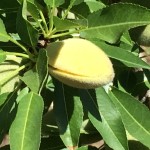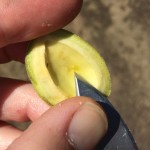
A few samples and farm calls have yielded nuts that are splitting pre-maturely. These nuts tend to be yellow in color and are often found dropping from the tree during high winds. Sometimes, the nuts have gum along the suture, or gum “specks” on the outside of the hull. These nuts could either be a “June Drop” as the tree is balancing the crop load or it could be kernel death caused by leaf-footed plant bug.
The nuts dropped could be the last dropping period within almonds. These nuts, when cut open, would be brown at the base of the nut, indicating the death of the connective tissue. Gum may exude from the suture of the hull. More importantly, there would be no noticeable holes through the hull or in the shell, although some degradation of the shell cells may occur.
In contrast, Leaf-footed plant bug would have a pin hole through the hull. This hole would often extend through the shell and into the kernel, causing a darkened spot at the point of entry and a shriveling of the kernel. Gum may appear on the exterior of the hull where the bug entered its mouth parts, but does not always occur. Although gumming is usually immediate (if it occurs), nut yellowing and subsequent drop — based on research — occurs 14-23 days after the point of feeding/damage, variety dependent. Gumming is not as frequent on younger nuts.

Knowing the cause of drop can provide information relevant to treatment decisions. If the drop is due to leaf footed plant bug, a treatment may be warranted. It is important, however, to determine if the bugs are still within the orchards. Since the nut drop is visible several weeks post feeding, the bugs may have moved out of the orchard and the spray may not provide the wanted control. More information can be found at the UC IPM website and this previous blog entry.

